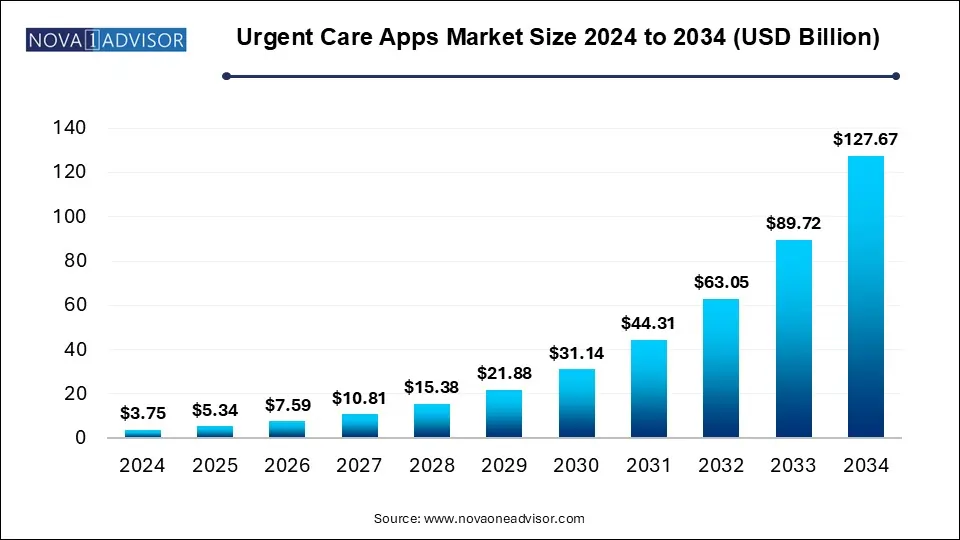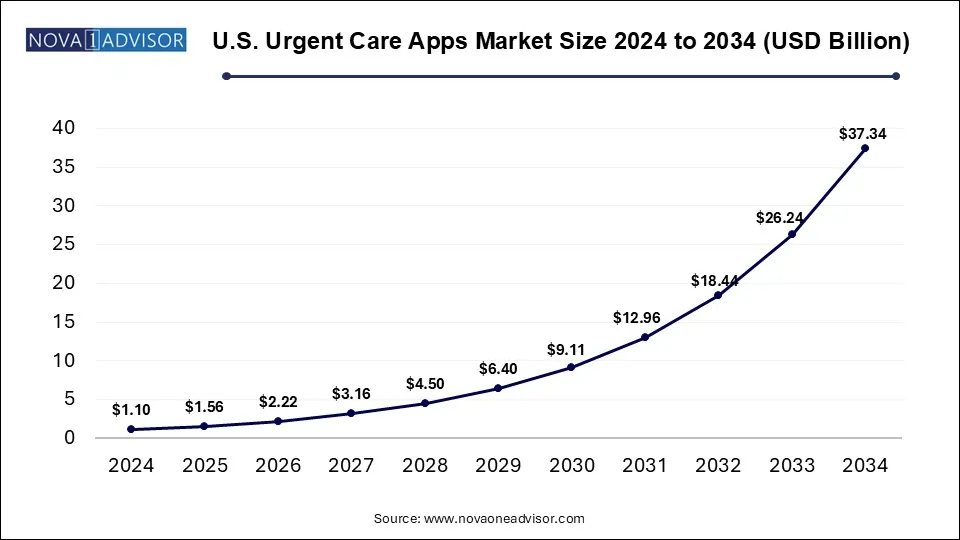Urgent Care Apps Market Size and Growth
The urgent care apps market size was exhibited at USD 3.75 billion in 2024 and is projected to hit around USD 127.67 billion by 2034, growing at a CAGR of 42.3% during the forecast period 2025 to 2034.

Urgent Care Apps Market Key Takeaways
- In 2024, post-hospital applications dominated the market with a 44.0% share.
- The pre-hospital emergency care and triaging applications segment is projected to experience the highest CAGR of 44.4% during the forecast period.
- The trauma segment accounted for the largest market share of 33.0% in 2024.
- Meanwhile, the stroke segment is anticipated to grow at the fastest CAGR of 43.9% throughout the forecast period.
- North America led the urgent care apps market, holding the largest share of 39.0% in 2024.
U.S. Urgent Care Apps Market Size and Growth 2025 to 2034
The U.S. urgent care apps market size was valued at USD 1.1 billion in 2024 and is expected to reach around USD 37.34 billion by 2034, growing at a CAGR of 37.77% from 2025 to 2034.

In 2024, North America held the largest share of the urgent care apps market at 39.0%, driven by the rising demand for 24/7 virtual healthcare access. This accessibility facilitates timely consultations, seamless healthcare system integration, and reduced physician workload while offering convenient care for multiple health conditions. For example, in October 2024, Cedars-Sinai introduced the Cedars-Sinai Connect mHealth app, which utilizes AI from K Health to provide virtual urgent and primary care. The app ensures round-the-clock access to medical professionals, optimizes patient intake procedures, and connects users with providers for video consultations. It also integrates care plans within Cedars-Sinai’s health record system, ensuring smooth transitions between virtual and in-person care while addressing physician burnout.
U.S. Urgent Care Apps Market Trends
In 2024, the U.S. dominated the urgent care apps market, fueled by the increasing adoption of advanced mobile health technologies, such as smartphone-based stethoscopes, which enable early detection of medical conditions and enhance personalized care using AI and real-time health data analysis. For instance, in February 2024, Sparrow BioAcoustics Inc. launched Stethophone, an FDA-approved software that transforms smartphones into medical-grade stethoscopes for monitoring heart health. The app features advanced visualizations and AI integration, improving early detection of cardiac conditions and enhancing personalized care for both healthcare professionals and consumers.
Europe Urgent Care Apps Market Trends
In 2024, Europe emerged as a promising market for urgent care apps. The increasing demand for swift healthcare access, particularly in remote and underserved areas, is a key growth factor. The integration of telemedicine, real-time health monitoring, and AI-powered diagnostics is improving patient care. Additionally, rising healthcare costs and the necessity to optimize medical resources are driving the adoption of urgent care apps to enhance efficiency and alleviate pressure on emergency services.
Asia Pacific Urgent Care Apps Market Trends
The Asia Pacific urgent care apps market is projected to expand at a CAGR of 5.5% over the forecast period. A major factor driving growth is the increasing implementation of AI-powered platforms that provide real-time patient data access, facilitate virtual consultations, and enhance healthcare delivery, particularly in remote regions. For example, in April 2022, Indian health tech startup HealthPlix launched HealthPlix Spot, the mobile version of its AI-powered EMR platform. The app allows doctors to access patient data in real time, conduct virtual consultations, manage appointments, send automated reminders, and offer telehealth services. Currently adopted by physicians in over 350 cities, it enhances healthcare accessibility and efficiency, particularly in rural India.
China Urgent Care Apps Market
China held the largest share of the Asia Pacific urgent care apps market in 2024. The market's growth is propelled by the rising demand for convenient healthcare access, particularly among urban and aging populations. The expansion of 4G and 5G networks, along with AI and machine learning integration, enhances remote healthcare services. Furthermore, government-led initiatives promoting digital health and telemedicine in rural regions are accelerating the adoption of mobile healthcare solutions.
India Urgent Care Apps Market
India's urgent care apps market is expected to expand at the fastest CAGR of 45.2% throughout the forecast period. The increasing penetration of smartphones, particularly in rural areas, coupled with growing internet access, makes India a key market for urgent care applications. Rising digital connectivity and the demand for accessible healthcare solutions further drive market growth. As of January 2023, India had over 700 million smartphone users, with 425 million residing in rural areas. More than half the population now owns a smartphone, and active internet users have surged by 45% since 2019, positioning rural India as a major force in the global digital revolution.
Report Scope of Urgent Care Apps Market
| Report Coverage |
Details |
| Market Size in 2025 |
USD 5.34 Billion |
| Market Size by 2034 |
USD 127.67 Billion |
| Growth Rate From 2025 to 2034 |
CAGR of 42.3% |
| Base Year |
2024 |
| Forecast Period |
2025-2034 |
| Segments Covered |
Type, Clinical Area Type, Region |
| Market Analysis (Terms Used) |
Value (US$ Million/Billion) or (Volume/Units) |
| Regional scope |
North America; Europe; Asia Pacific; Latin America; MEA |
| Key Companies Profiled |
Allm Inc.; Johnson & Johnson Services, Inc.; PatientSafe Solutions (Stryker); AlayaCare; Twiage Solutions Inc.; TigerConnect; Siilo from Doctolib; Imprivata, Inc.; Medisafe |
Urgent Care Apps Market By Type Insights
In 2024, post-hospital applications accounted for the largest market share at 44.0%, driven by the increasing demand for digital solutions that enhance patient care, facilitate communication, and streamline health condition monitoring after treatment. For instance, in November 2024, WoundZoom introduced WoundZoom Light, a mobile application designed to support healthcare providers in post-acute care settings. The app enables clinicians to capture images, monitor wound healing progress, and share patient data for collaborative treatment. This innovation aims to enhance care quality, improve communication, and optimize wound management in post-acute environments.
The pre-hospital emergency care & triaging applications segment is projected to experience the highest CAGR of 44.4% during the forecast period. These apps play a critical role in improving response times by facilitating quick coordination with emergency services. They enhance assessment accuracy through symptom checklists, ensuring timely and appropriate care. Additionally, they help optimize healthcare resources by prioritizing critical cases, ultimately reducing the burden on emergency departments.
Urgent Care Apps Market By Clinical Area Type Insights
In 2024, the trauma segment held the largest market share at 33.0%, largely due to its effectiveness in providing timely and efficient emergency responses by connecting victims with trained responders. This approach enhances pre-hospital care, reducing mortality and morbidity associated with injuries. For instance, in March 2021, the Trauma Care International Foundation launched an Emergency Response app designed to link emergency victims with trained volunteers. The app aims to strengthen pre-hospital care in Nigeria, particularly in Lagos, by decreasing injury-related complications and fatalities. It also complements existing emergency frameworks and fosters collaboration with stakeholders to improve trauma care systems across the country.
The stroke segment is anticipated to grow at the fastest CAGR of 43.9% over the forecast period, attributed to its ability to facilitate rapid detection and diagnosis of stroke symptoms. These applications enable immediate medical intervention, significantly improving patient outcomes. They also support real-time monitoring and communication between patients, caregivers, and healthcare professionals, ensuring swift action during critical situations. Moreover, they help streamline emergency resource allocation by providing fast access to stroke care facilities, minimizing treatment delays.
Some of The Prominent Players in The Urgent Care Apps Market Include:
Segments Covered in the Report
This report forecasts revenue growth at country levels and provides an analysis of the latest industry trends in each of the sub-segments from 2021 to 2034. For this study, Nova one advisor, Inc. has segmented the urgent care apps market
By Type
- Pre-hospital Emergency care & Triaging Apps
- In-hospital Communication & Collaboration Apps
- Post-hospital Apps
-
- Medication Management Apps
- Rehabilitation Apps
- Care Provider Communication & Collaboration Apps
By Clinical Area Type
- Trauma
- Stroke
- Cardiac Conditions
- Others
By Regional
- North America
- Europe
- Asia Pacific
- Latin America
- Middle East and Africa (MEA)


